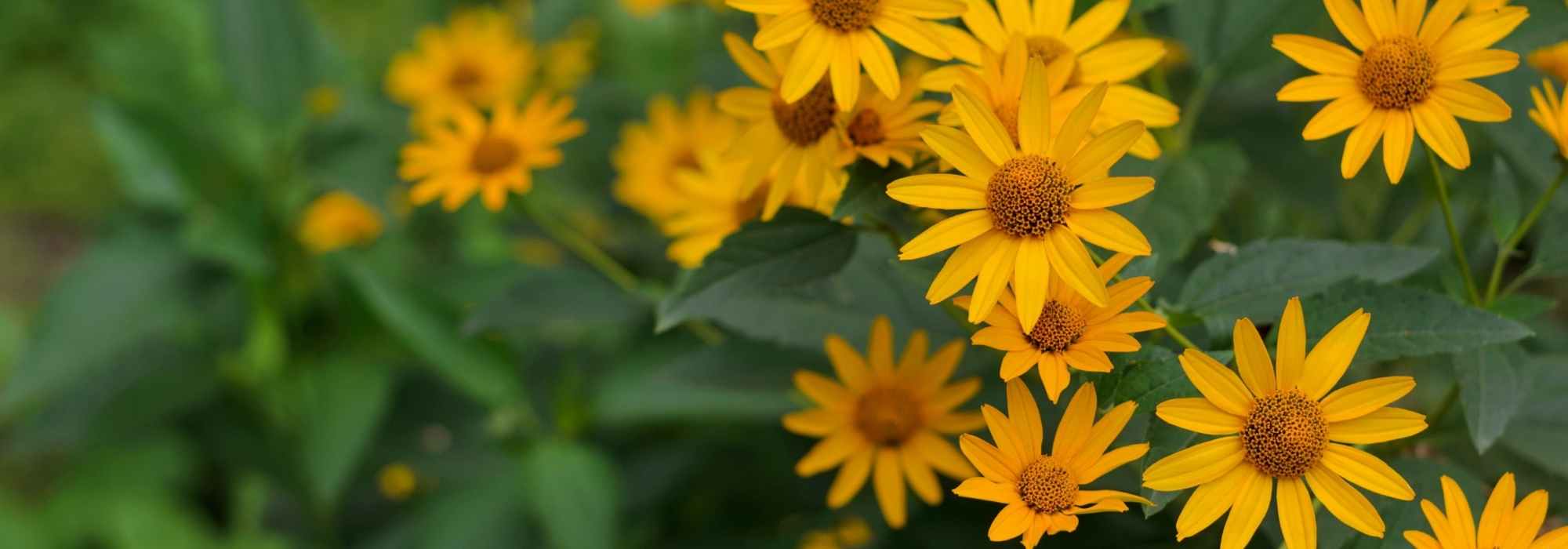
Heliopsis, Heliopsis: planting, cultivation, and care
Contents
Heliopsis in a nutshell
- Heliopsis is a beautiful perennial that is very easy to grow
- It blooms for a long time during the lovely season, in shades of yellow or orange
- Very resilient and hardy, it requires little maintenance
- Valued in the garden as well as in a cut flower arrangement, it delights both beginner and experienced gardeners
The word from our expert
Heliopsis is a large and beautiful perennial native to America, belonging to the family of Compositae (Asteraceae). Reminiscent of the sunflower, it is much more accommodating than the latter, and its more modest dimensions allow it to be easily integrated into any garden. Its finely cut foliage, which can be green, purple, or variegated with pink, serves as a backdrop for an abundant flowering period that extends from summer to mid-autumn. The flowers, with their numerous petals, are single, semi-double, or double, and are available in bright shades of yellow and orange. Too rarely used, it deserves a prominent place in naturalistic borders, especially since it adapts to all types of soil and is quite hardy. A sun-loving plant, it is drought-resistant and has few enemies. Its ornamental qualities are appreciated both in the composition of relaxed and natural-looking borders and in the creation of rustic-style bouquets.
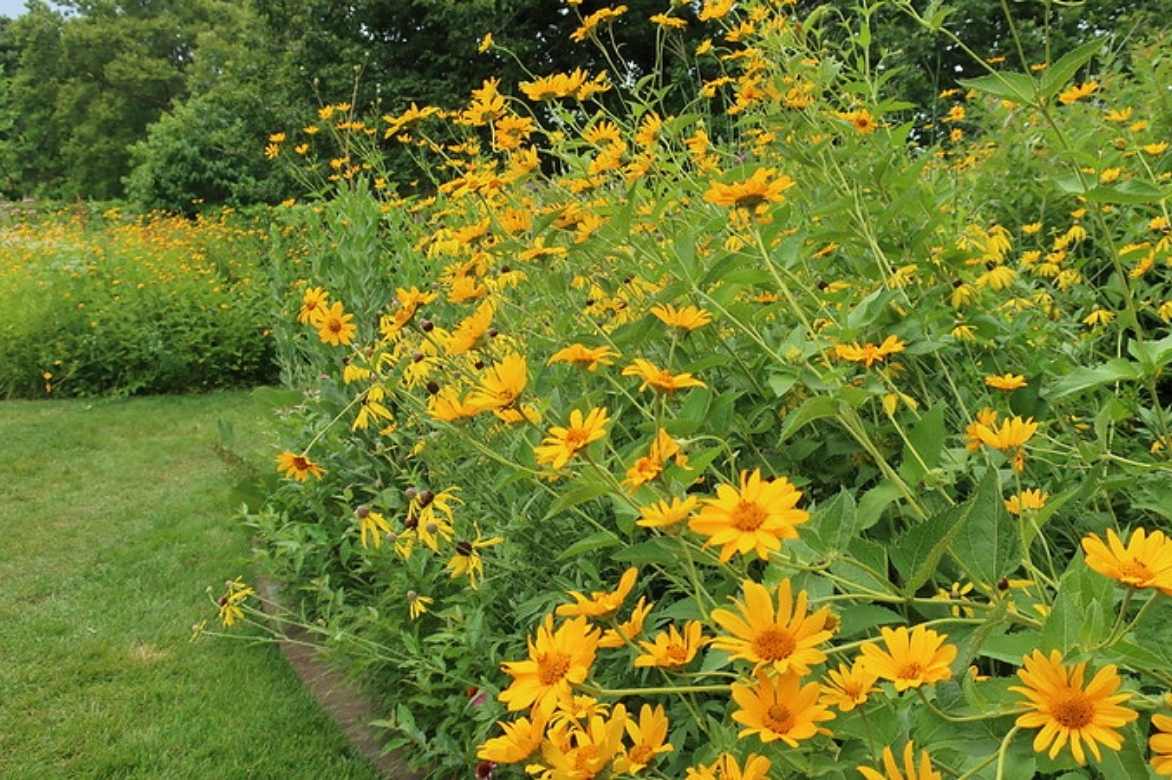
Description and Botany
Botanical data
- Latin name Heliopsis
- Family Asteraceae (Compositae)
- Common name Heliopsis, False sunflower
- Flowering Summer to mid-autumn
- Height 60 cm to 1.5 m x 60 cm
- Exposure full sun, partial shade
- Soil type Any well-drained soil
- Hardiness good (-15°C)
The Heliopsis, or Helioptide, is a large perennial from the Asteraceae family (or Compositae), just like Asters, Echinaceas, Dandelions, and Artichokes.
While around a dozen species belong to this genus (including Heliopsis anomala, Heliopsis buphthalmoides, Heliopsis decumbens, or Heliopsis filifolia, to name just a few), only Heliopsis helianthoides is cultivated for ornamental purposes in our gardens, but this species comes in many cultivars, varying in size and shades.
The Heliopsis is a very floriferous perennial that grows spontaneously in clear forests, savannas, and meadows, from Canada to Mexico, passing through the United States.
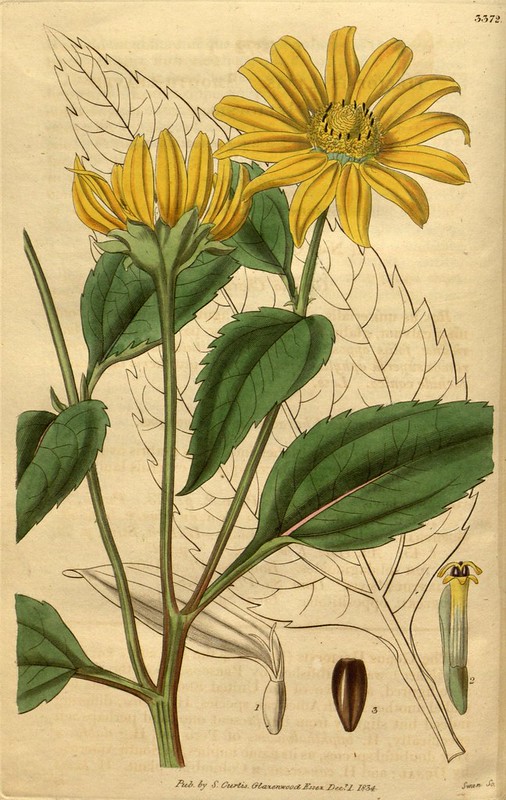
Heliopsis, botanical illustration from 1834
Underutilised in gardens, it is nevertheless a plant of great robustness, capable of withstanding drought, and very hardy. Its ease of cultivation, great adaptability, and low maintenance are all assets that justify its inclusion in the borders of both beginner and experienced gardeners. It is also valued for its natural and rustic appearance, as well as for its abundant flowering, which occurs at a time when the rest of the garden may take a break under the summer heat.
The Heliopsis forms a woody, non-invasive clump, from which emerge in spring long and sturdy stems, slightly branched and adorned with decorative foliage. The deciduous leaves are about ten centimetres long, rough, lanceolate to ovate, and dentate. More or less triangular, they are arranged alternately along the stems and display various shades of green, sometimes heavily tinged with purple or red on mahogany stems (Heliopsis ‘Summer Nights’). Some varieties have variegated foliage: white with green veins in Heliopsis ‘Loraine Sunshine’, it mixes green, cream, and pink in Heliopsis ‘Summer Pink’. Heliopsis helianthoides var. scabra is distinguished from the type by its rougher stems and leaves, which are also thicker.
The Heliopsis flowers from summer to mid-autumn, with great generosity. The inflorescences, in daisy form with diameters ranging from 2 to 10 cm, are borne in solitary heads, with the central tubular florets forming a more or less domed disc. Numerous ligules (fused petals) radiate around the periphery. The flowers can be single, semi-double, or double depending on the varieties. The petal colour is predominantly yellow, varying from bright to golden, but some varieties, such as Heliopsis ‘Burning Hearts’, take on warm orange tones. The central disc often creates a beautiful contrast with the petals, appearing in bronze, orange, mahogany, or darker yellow, before turning brown once flowering is finished, leaving behind seeds that are a delight for birds.
The name Heliopsis comes from the Greek “Helios” (the sun) and “opsis” (which resembles), and this perennial bears similarities to the Sunflower (Helianthus), but is more modest in size and much more accommodating. The tallest cultivars reach around 1.20 m to 1.50 m (Heliopsis helianthoides ‘Summer Nights’) with a width of about 50 cm, the average being 90 cm. More compact and branched varieties are available, such as Heliopsis helianthoides ‘Tuscan Sun’, which remains at 60 cm in all directions, making it suitable for pot cultivation.
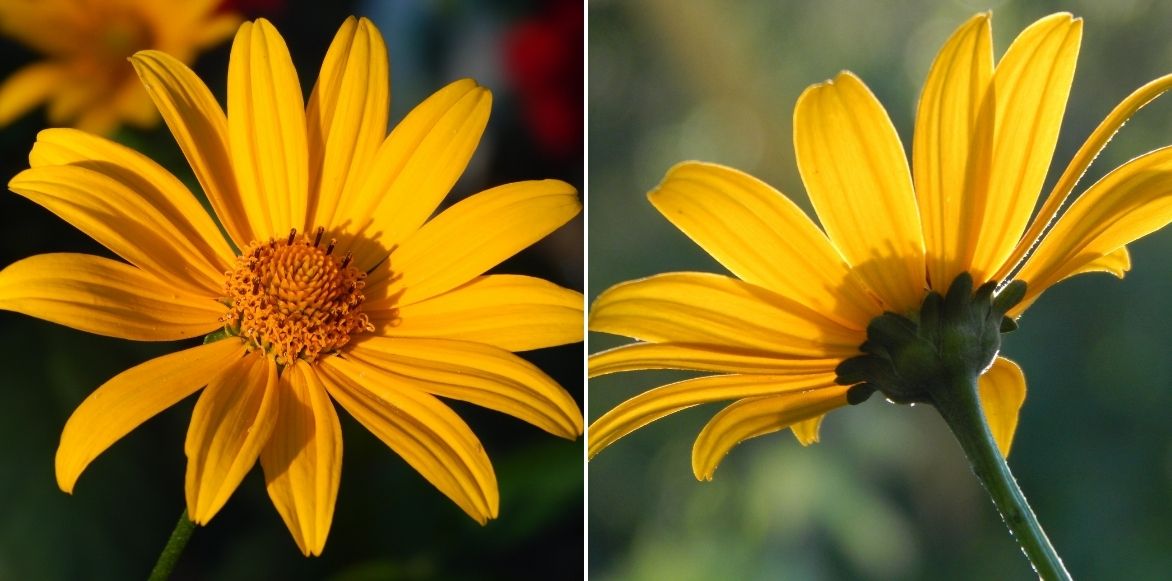
A reliable and sturdy perennial, the Heliopsis can endure difficult conditions, but it thrives best in any fertile, well-drained soil, whether acidic, neutral, or calcareous, and remaining moist.
It prefers sunny exposures but can tolerate partial shade, where its floriferousness may be slightly less generous, and where its habit, usually upright and flexible, may become looser, sometimes requiring light staking.
The flowers of Heliopsis are highly valued in bouquet arrangements, adding warmth and brightness.
The Heliopsis has few enemies and diseases: gastropods may be attracted to its young shoots, and powdery mildew may develop on the plant in some more sensitive varieties. In any case, it is wiser to avoid windy situations to preserve its elegant habit.
Read also
Sunflower: sowing, planting, careThe different varieties of Heliopsis
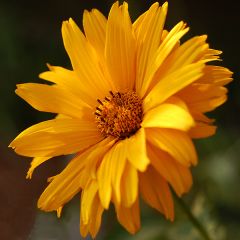
Heliopsis helianthoides var. scabra Sommersonne
- Flowering time July to October
- Height at maturity 90 cm
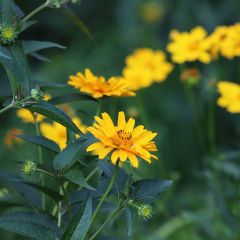
Heliopsis helianthoides Tuscan Sun
- Flowering time July to October
- Height at maturity 55 cm
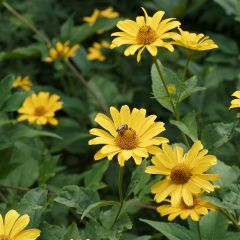
Heliopsis helianthoides var. scabra
- Flowering time July to October
- Height at maturity 1,50 m
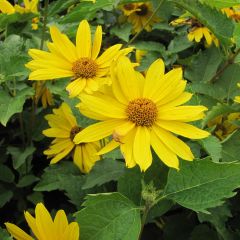
Heliopsis helianthoides Mars
- Flowering time July to October
- Height at maturity 1,50 m
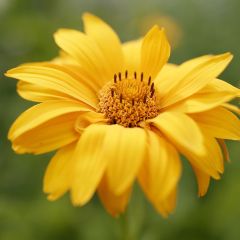
Heliopsis helianthoides var. scabra Venus
- Flowering time August to October
- Height at maturity 90 cm
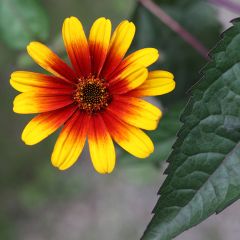
Heliopsis helianthoides var. scabra Burning Hearts
- Flowering time July to October
- Height at maturity 1,20 m
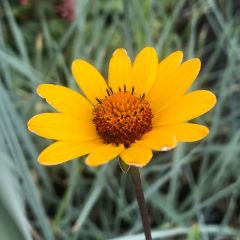
Heliopsis helianthoides var. scabra Summer Nights
- Flowering time August to October
- Height at maturity 1,20 m
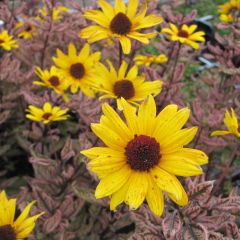
Heliopsis helianthoides Summer Pink
- Flowering time July to October
- Height at maturity 90 cm
Discover other Heliopsis
View all →Available in 3 sizes
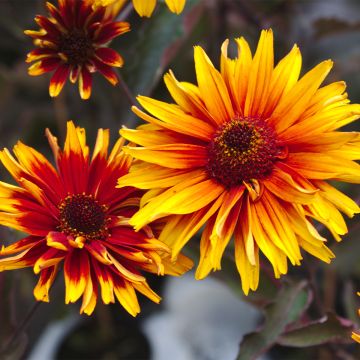
Available in 3 sizes
Available in 1 sizes
Available in 1 sizes
Available in 1 sizes
Available in 3 sizes
Available in 2 sizes
Available in 1 sizes
Available in 3 sizes
Available in 1 sizes
Planting Heliopsis
Where to plant?
The Heliopsis is a sun-loving perennial that prefers open exposures, but sheltered from strong winds. Highly adaptable to soil types, it can be planted in acidic, neutral, or calcareous soil, as long as it is well-drained. Its main enemy is indeed waterlogged soil in winter, although it can withstand temperatures as low as -15°C, or even lower. Fertile soil promotes its growth and generous flowering, but it also adapts to poorer soils.
The tallest varieties should be placed in the middle or back of the border, while the more compact ones can be positioned at the front, serving as a colourful groundcover.
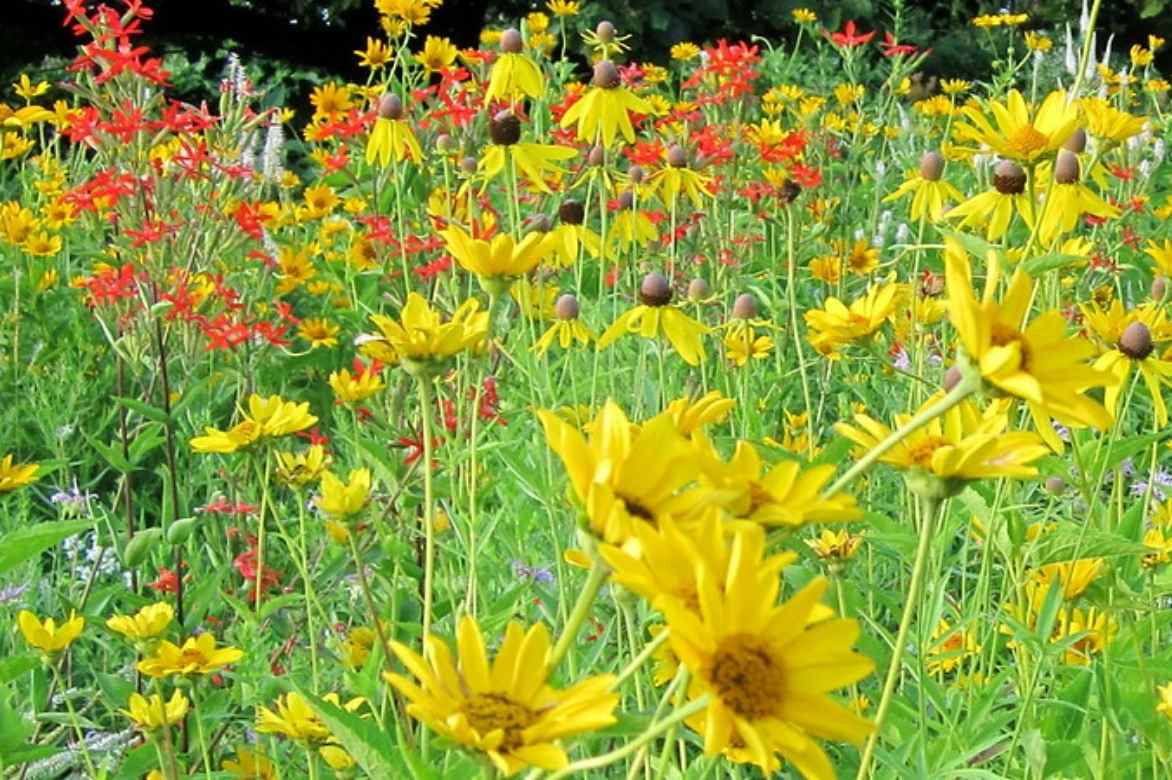
Heliopsis, Silene regia, and Ratabida pinnata (Photo: KM)
When to plant?
The best planting time is autumn (before the first hard frosts) or early spring (before the heat sets in). Depending on the chosen time, the pot may seem to contain only soil. Don’t worry, this simply means the plant is in dormancy and currently has no visible aerial parts. However, its roots are very active and ready to restart growth the following spring.
How to plant?
Planting in the ground:
- Soak the pot in a volume of water to moisten the entire root ball.
- In the meantime, dig a hole that is 2 to 3 times the size of the pot in all directions (about 30 cm for a 9 cm pot).
- In heavy, compact soil, improve drainage by placing a layer of drainage material about ten centimetres deep at the bottom of the hole (gravel, clay balls, pumice, etc.).
- Mix one or two handfuls of well-rotted compost with the extracted soil.
- Start pouring your mixture into the hole, then, after removing the plant from its pot, place it in the centre so that its top is level with the soil.
- Fill in with the remaining mixture, without burying the collar (the junction of stems and roots).
- Lightly firm with your fist, and water generously.
- Mulch the area for 30 cm around the plant, with a thickness of 5 to 10 cm (RCW, flax flakes, straw, etc.).
→ In case of insufficient rainfall, monitor watering in the following weeks. The soil should remain moist but not waterlogged.
Planting in a pot:
- Choose a pot that is 30 to 50 cm in all dimensions, with a drainage hole.
- Place a layer of drainage at the bottom, about 10 cm thick.
- Fill your pot with a mixture of potting soil or garden soil (1/2) and commercial compost (1/2), to which you can add a handful of well-rotted compost.
- After allowing the plant to soak in water in a bucket, remove it from the pot and position it, without burying it.
- Complete with the remaining mixture, leaving the top of the plant level with the soil.
- Water generously, in several applications to thoroughly moisten the entire substrate.
- Mulch with your choice of material (vegetal or mineral).
→ Monitor watering in the following weeks.
Caring for and maintaining Heliopsis
General Care
Heliopsis is a very easy-going plant, low-maintenance and reliable. However, a few care tips will ensure you get the best out of it:
- Ensure the base remains moist, especially during the growth period (spring) and flowering period (summer). Water generously, but infrequently, in cases of severe drought.
- In May, pinch back the young shoots or cut the stems back by a third. This will slightly delay flowering, but it results in a denser plant and encourages beautiful flowering on sturdy stems.
- During the flowering period, regularly cutting back faded flowers encourages the plant to produce new inflorescences.
- Once the flowers have faded, cut the stems as low as possible. You can also leave them in place until the vegetation restarts, providing winter shelter for insects and allowing birds to feed on the seeds produced.
- Every year, add two or three handfuls of mature compost at the base and lightly scratch the surface. Take the opportunity to renew or top up the mulch.
- If the stems tend to flop, provide light staking.
- Every 3 to 4 years, to maintain the plant’s vigour, divide it.
- If you are growing your Heliopsis in a pot, monitor watering during the growing season. Allow the substrate to dry out between waterings. Consider adding a suitable fertiliser once a month during the growth and flowering periods, following the recommended dosages on the packaging.
Diseases and Potential Issues
- Heliopsis has few enemies, but slugs and snails can be fond of its young shoots. Discover our tips for naturally combating gastropods.
- Some varieties are more susceptible to powdery mildew, which is characterised by a white fluff on the foliage or flower buds. Harmless, it is primarily unsightly. To understand this minor issue, check out our guide on the symptoms and treatments of powdery mildew.
Multiplying Heliopsis
The simplest method to multiply Heliopsis is by clump division, to be carried out at the beginning of spring, when growth resumes. This operation, which is advisable to perform every 3 to 4 years, is even recommended to maintain the plant’s vigour.
- If possible, water the young plant to be divided the day before the chosen day
- Dig up the plant with a spade, keeping as many roots as possible
- Using a sharp and clean tool, divide into several clumps. Each of them should have a few roots and some stems
- Replant immediately in the desired location
- Water and mulch
Associating Heliopsis in the garden
Heliopsis, like all yellow flowers, is not always easy to pair in the garden. However, its origins lend themselves to cheerful mixes with a wild and naturalistic appearance, reminiscent of the vast American prairies. If possible, plant it in masses, alongside other tall perennials such as Heleniums, Eupatoriums, Phlox paniculata, Coreopsis, or Rudbeckias.
Play with the shapes of the inflorescences by adding the spike flowers of Veronicastrum, Goldenrods, Persicarias, or Kansas Plumes.
Also consider the light flowers of Gauras, Thalictrum, Gypsophilas, or the original Cloud Cabbage, Crambe cordifolia.
Originality can also come from the electric blue fluffy heads of some Echinops, or the violet touches of Buenos Aires Verbena, whose shades also provide a complementary colour to that of Heliopsis. Blues and purples can also be introduced by Agastaches, Sages, Campanulas, Nepeta, or the highly floriferous Geranium ‘Rozanne’. Finally, Asters mainly begin their flowering when Heliopsis starts to decline, thus taking over. Just be sure to respect the heights to create different layers of flowers.
The summer flowering of Heliopsis links the seasons and heralds autumn.
While flowers are important in a garden, foliage is equally significant, especially since its presence is often longer lasting. Grey and silver foliage helps to tie colours together while enhancing them. Many perennials can thus act as moderators, such as Artemisias, Ballota, Stachys, and other Helichrysum.
It can also be interesting to pair the yellow of Heliopsis with dark foliage, in shades of bronze or purple. Consider plants like ‘Red Dragon’ Persicaria or a purple Sedum (perhaps ‘Purple Emperor’?). The Pennisetum ‘Rubrum’, although frost-sensitive, can also serve as a counterpoint for a season, both in colour and in its habit and airy spikes.
Grasses are indeed plants that allow for almost any combination. A few clumps of Miscanthus, Panicum, or Stipa with blonde culms are thus very effective.
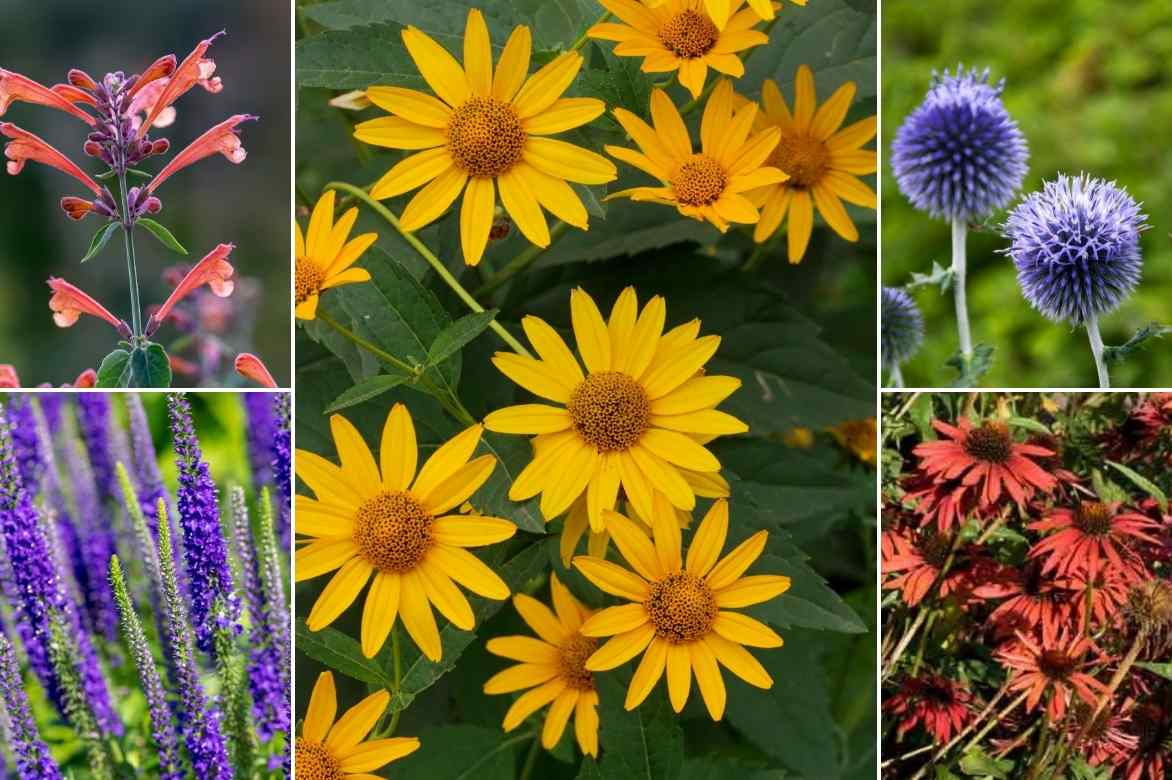
Heliopsis in warm colours pairs beautifully with Agastache aurantiaca ‘Tango’, the blue of Veronicastrums and Echinops, and the orange tones of Echinacea ‘Hot Summer’,
→ Discover 5 ideas for pairing with Heliopsis in our advice sheet!
Useful resources
- All our varieties of Heliopsis
- Discover our tips for growing Heliopsis in pots
- Also discover Helianthus, or perennial sunflowers.
- Subscribe!
- Contents































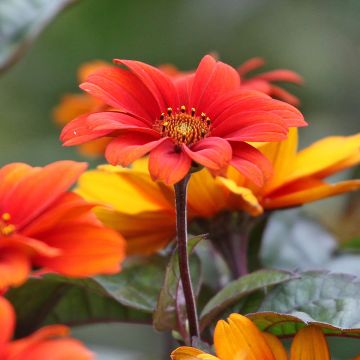



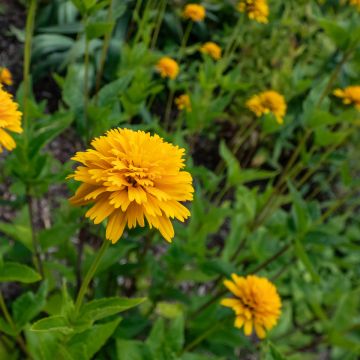
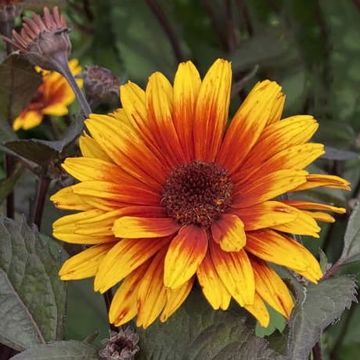
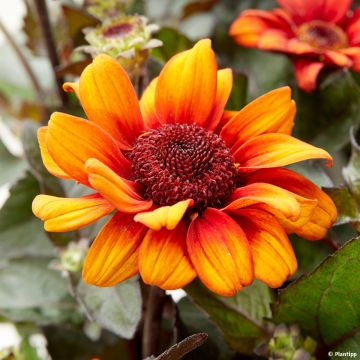
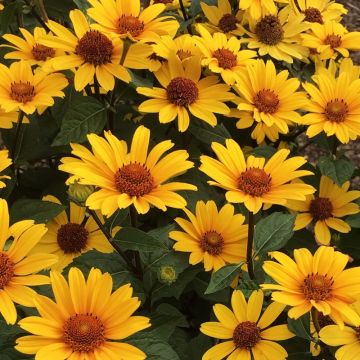

Comments